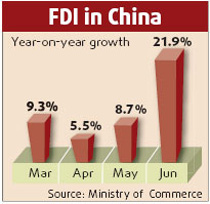Milk prices dropped from last winter to this spring. Dairy farmers in Shanyin, a famous dairy county in Shanxi Province, butchered or sold their relatively low-production cows. As of June this year the entire county eliminated 7,000 cows, approximately 10 percent of the total herd.
Milk prices rose this August and September, and later a milk shortage appeared. Some milk buyers even drove to dairy farmers' homes to try to make deals; competition was that fierce. The price of cows in May and June ranged between 5,000 to 6,000 yuan (about US$ 666 to 799) but hiked up to 8,000 to 9,000 yuan (about US$1,066 to 1,199) between August and September. Farmers who butchered or sold their cows now feel regret.
Wang Fu, a cow farmer in Gucheng village of Shanyin, sold his three-year-old cow for only 3,000 yuan four months ago, because the price of yielded milk wasn't enough to pay for the animal's feed. He said that he now felt great regret because the price of his former cow would be at least 10,000 yuan now.
Feed for milch cows is a major industry in Shanyin. Statistics show that more than 75,000 cattle existed in the whole county by the end of 2006. Milk output had reached 256,000 tons per year. The average income was 3,388 yuan, with one third coming from cow feed.
But rising grain and feed prices have directly influenced cow maintenance costs. Finally, farmers had to butcher their cows for beef.
The situation took a turn for the better in August and September, said a vice director of Shanyin Animal Husbandry Bureau who are surnamed Kang. "The purchase price for milk rebounded from 1.7 yuan per kilogram in June to the current 2.4 yuan. Milch cow prices also recovered, from 5,000 yuan to 6,000 yuan per head in May and June to between 8,000-9,000 yuan in August and September."
Resurging prices mean good news for diary farmers, but for those who have sold their cows at low prices or butchered them, this certainly gives them good reason for regret.
Seeing farmers struggling in this dilemma, the Shanyin government has taken measures to improve the situation, according to Kang.
"A dairy farm with 300 head in stock can get financial aid ranging from 500,000 to 750,000 yuan from the provincial, city and county governments. Currently 4 million yuan in total has been given to six farms in the county," Kang said.
The county and city governments have also started to subsidize farmers for construction of silage ammonification pools in 2005, at 30 yuan per cubic meter. From 2005 to 2007, a total of 2.05 million was earmarked."
"Certainly, milk price hikes are fundamentally determined by the supply and demand situation in the market," said Kang. "Reduced numbers of cows, combined with rebounded market demands have both led to milk supply shortages. Dairy firms have scrambled to secure milk from dairy farmers, causing prices to surge again."
According to Kang, there are seven dairy processing firms in Shanyin, including its own local brand name, Gucheng Dairy Firm, and two national diary giants, Yili and Mengniu. A new comer, Yashili, an emerging food brand, settled in a neighboring county and recently joined these three dominant players.
"Due to increasing demands, dairy farmers may see a boost in their income," Kang speculated.
However, the price resurgence did not cheer up Duan Guoqiang, deputy county head in charge of animal husbandry sector.
"This is only a periodical and recovering rebound," said Duan. "Animal husbandry is still a weak sector in the national economy. Dairy farmers are the weakest link in the whole dairy chain."
"We must wait two or three years to mark a significant period to gauge milk prices," Duan added.
At the end of 2004, the cost of milk was 2.3 yuan per kilogram. A milk cow producing 30 kilograms of milk a day can be sold for as much as 20,000 yuan. Even a newborn calf could be sold for 5,000 yuan. These high prices stimulated strong enthusiasm in local farmers to buy cows, Duan said.
However, from the latter half of 2005 to the first half of this year, the price of milk has dropped to 1.7 yuan per kilogram. Lower prices, plus higher feed costs, greatly dampened farmers' zeal.
"China's dairy industry is still plagued by disorderly competition. Big enterprises usually snatch windfall profits by squeezing profits from the dairy farmers," Duan said.
Price wars in China's dairy industry began in 2002. However, they were not as fierce and frequent as today, occurring only two or three times a year. But starting from 2004, competition became white-hot. Now, twice a month sales promotions appear as more and more dairy firms launch campaigns.
"Costs will all eventually transfer to dairy farmers. Already these price wars have severely hurt their interests."
Duan urged the state to take measures to protect the interests of dairy farmers. "Like grain and pig farming subsidies, the government can also allot similar subsidies to farmers based on their milk output or milk heads."
He also called for optimization in breeding milch cows.
"The selling and butchering of cows has dealt a heavy blow to dairy farmers. Conversely, it also helped to streamline the dairy infrastructure by eliminating low-output and hard-to-get pregnant cows," Duan said.
"It also tells us that we must improve the quality of our dairy herds," Duan said. "When prices are low, low-output cows cause losses but high-output cows will still generate profits. The government along with science and technology departments must work together to stage improvements."
(China.org.cn by Chen Lin and Yuan Fang, September 24, 2007)


